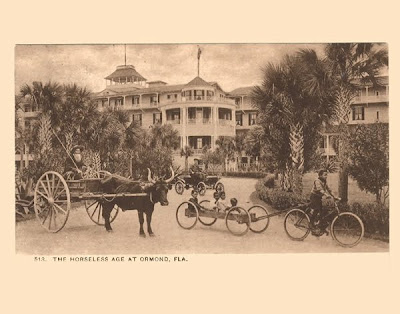



I would like to introduce you to my friend Aldo Carrer. He is also a veteran motorcycle enthusiast and collector of all things paper and photographic regarding the same. His collection of motorcycle photos numbers around ten thousand pieces from which he has selected a great many to portray in three books that he has published. Aldo lives in
His first book was published in November of 2003. It is a photographic study of motorcycles from 1894-1944. Descriptions of the photos are supplied, but unfortunately for us here in
In April of 2006 Aldo published his second book. It is titled “The Dawn of the Motorcycle” and covers the years from 1894-1906. This book is truly a wonderful look at those very early motorcycles that set the direction in which future manufacturers would improve upon and advance the sport of motorcycling. There are so many rare and remarkable images of those long ago days that one has to marvel at the effort Mr. Carrer has put into accumulating such an astounding collection. This book is wonderfully bound with a hard printed cover and the paper is an exceptionally nice gloss stock. Within those pages you will see not only the images of motorcycles, but have a good look at the riders and the clothing of the day. There are 189 large and well presented photos in this book of 127 pages. This book, unlike the first is written in Italian with English translation.
The next book from Aldo is titled "The Motorcycle's uniform during the World War One". It was published in 2008 and is a comprehensive look at the military motorcycles and the uniforms of their riders during the Great War. Within the 183 pages of this book are 264 wonderful photos that are large and clear portraying aspects of the military from that era that most people do not get a view of. The book is broken into chapters by motorcycle manufacturer which in turn shows the uniforms worn by the soldiers of each country. This book is again a very high quality publication at 8" x 12" in size with hardcover and heavy gloss paper. This is a book that motorcyclists and military historians alike will be eager to own.
Mr. Carrer’s latest publishing effort has out done the other two in terms of quantity of photographic images and overall scope of the subject. Published in 2010, this massive, hard covered book is 360 pages in length and again printed on superb high quality paper. There are 538 glorious, black and white images from the years 1894-1945. Titled “The Women, The Motorcycle, and the Womens Fashion Trends”, this is a book that any lover of history, motorcycles and the women who rode them will be fascinated with and certainly want to own. The images are stunning in their observation of the riders and clothing trends over the decades. The book is large, 9” x 12” and heavy at just under five pounds. Photo’s fill every page with a great many covering a two page spread while many others range from full or half page to pages with three or four images each. Written in Italian, the book has been translated by his sons Marco and Maurizio into English and German. The motorcycles range from some of the rarest every made to names we all know like Harley-Davidson and Indian to those European brands that most of us have never heard of.
The above books are being sold through Mr. Carrer from his home in
